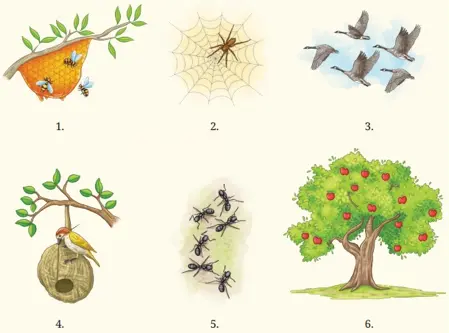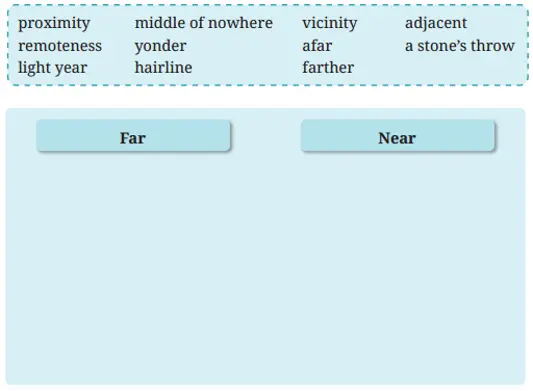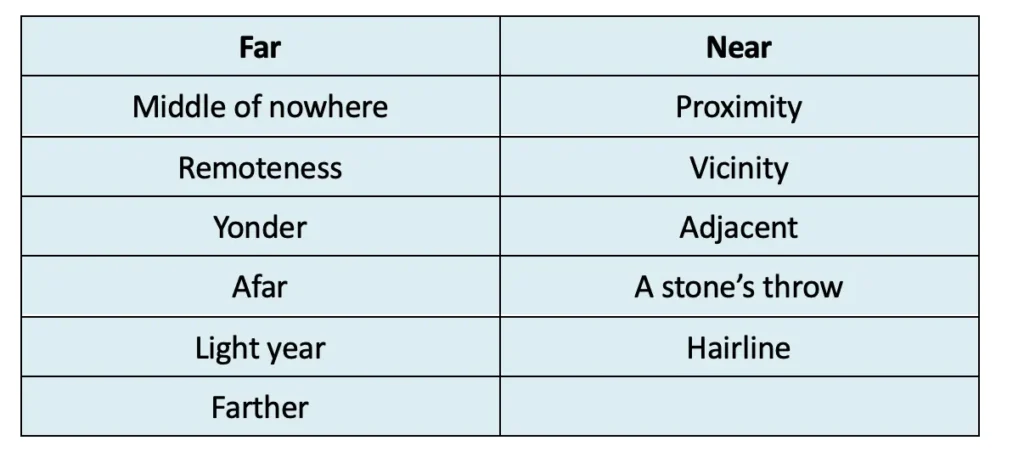Class 7 English Poorvi Chapter 2 Try Again NCERT Solutions
These Class 7 English Poorvi Chapter 2 Try Again NCERT Solutions provide students with everything they need to understand Chapter 2 Try Again. These solutions include question answers, fill-in-the-blanks, multiple-choice questions, grammar portions, and writing exercises.
Class 7 English Poorvi Chapter 2 Try Again NCERT Solutions Questions Answers – PDF Download
Let us do these activities before we read. (Page 16)
Ⅰ Who inspires you to do your best?
Answer:
My parents inspire me to do my best. Their hard work and dedication to their responsibilities motivate me every day.
Ⅱ Work in pairs, identify what you see in the pictures given below. What can we learn from them? Share your answers with your classmates and the teacher.

Answer:
1. The picture shows honey bees working on a hive. Bees work together throughout the day to collect nectar from flowers and teach us the value of teamwork and dedication.
2. The picture shows a spider building its web. Spiders spin their webs with great skill and patiently wait for their prey to get caught in them. This teaches us to work hard, develop our skills, and adopt a never-give-up attitude towards life.
3. The picture shows a flock of birds flying in the sky. A flock of migratory birds travels thousands of kilometres together in perfect harmony to reach their destination. They teach us the importance of unity, perseverance, and shared purpose.
4. The picture shows a bird building a nest on a branch of a tree. It teaches us that small, persistent efforts towards our goals bring us closer to them.
5. The picture shows a colony of ants. They are always busy collecting food together, and if something blocks their path, they find another way. They teach us unity, cooperation, and a never-give-up attitude.
6. The picture shows a big tree bearing apples. It teaches us that good things take time to grow and bear fruit, just like an apple tree that takes years to mature and produce apples.
Let us discuss (Page 19)
Ⅰ Complete the summary of the poem by filling in the blanks with suitable words from the text given in the box below. Share your answers with the teacher. An example has been given.

The poem, written in a narrative style, tells the story of King Bruce of Scotland, who was feeling 1. _____________ after failing multiple times to achieve something 2. _____________ for his people. In a moment of 3. _____________, he observed a spider trying to reach its web high above. The spider 4. _____________ every time it fell after getting close to its goal. It made nine 5. _____________ and finally succeeded. The king said that the spider had 6. _____________ and so would he. Inspired by the spider’s determination, King Bruce decided to 7. _____________. When he 8. _____________ this time, he ultimately succeeded.
Answer:
1. low
2. great
3. despair
4. tried
5. attempts
6. conquered
7. try
8. mounted
Ⅱ Complete the following sentences suitably.
1. We can say that the poet uses the narrative style because ________.
Answer:
She wants to tell the story of King Bruce and a spider through a series of chronological events leading to an unexpected end.
2. The central idea of the poem is ________.
Answer:
The central idea of the poem is that we should never stop trying, as perseverance and determination help us overcome failures and achieve success.
Ⅲ Pick three examples from the poem for each of the following:
1. lines that describe the spider’s efforts
Answer:
(i) It soon began to cling and crawl
Straight up with strong endeavour.
(ii) Up, up it ran, not a second to stay,
To utter the least complaint.
(iii) Steadily, steadily, inch by inch,
Higher and higher he got.
2. alliteration (the repetition of the same consonant sounds at the beginning of closely connected words)
Answer:
(i) cling and crawl.
(ii) slippery sprawl.
(iii) defied despair.
Ⅳ Why does the poet repeat the following words or phrases in the poem?
tried and tried; steadily, steadily; up, up
Answer:
The poet repeats the given words in the poem to emphasize the spider’s determination and perseverance to reach its web despite falling many times.
Ⅴ Fill in the blanks by choosing the correct answer from within the brackets.
1. The rhyme scheme of the poem is ____________. (AABB/ ABBA/ ABAB)
Answer:
AABB
2. ‘Bravo’ is an example of ____________. (conjunction/ interjection/ adjective)
Answer:
Interjection
3. The poet uses ‘twas and ‘tis for the sake of ____________. (rhythm/ rhyme/ contraction)
Answer:
contraction
Ⅵ The spider’s climbing is compared to King Bruce’s own struggles. Just as the spider repeatedly attempts to reach its web, Bruce is trying to achieve a great deed for his people. This poetic device is called metaphor. It strengthens the poem’s message about perseverance—keep trying till we succeed.

1. Read the following sentences and identify metaphors and similes. Write M for metaphor and S for simile.
(i) He ran as fast as a cheetah.
(ii) The world is a stage.
(iii) The night was as dark as coal.
(iv) He sang like an angel.
(v) Her voice was music to his ears.
(vi) The classroom was a zoo.
(vii) The baby slept like a log.
(viii) Her smile was as bright as the sun.
(ix) The lake was a mirror, reflecting the sky.
Answer:
(i) He ran as fast as a cheetah. (S)
(ii) The world is a stage. (M)
(iii) The night was as dark as coal. (S)
(iv) He sang like an angel. (S)
(v) Her voice was music to his ears. (M)
(vi) The classroom was a zoo. (M)
(vii) The baby slept like a log. (S)
(viii) Her smile was as bright as the sun. (S)
(ix) The lake was a mirror, reflecting the sky. (M)
2. Read the following sentences and transform the similes to metaphors and metaphors to similes. Two examples have been given.
(i) Knowledge spreads like the branches of a mighty tree.
Knowledge is a spreading branch of a mighty tree.
(ii) His courage was a beacon, guiding us through the storm.
• His courage was as bright as a beacon guiding us through the storm.
• His courage was like a beacon guiding us through the storm.
(iii) The book was a treasure chest, filled with endless adventures.
Answer:
The book was like a treasure chest, filled with endless adventures.
(iv) Her laughter was a melody that brightened the darkest days.
Answer:
Her laughter was a melody that brightened the darkest days.
(v) The mountain stood as a guard, watching over the valley below.
Answer:
The mountain was a standing guard, watching over the valley below.
(vi) The night was like a velvet cloak, wrapping the world in mystery.
Answer:
The night was a velvet cloak, wrapping the world in mystery.
(vii) Her thoughts were like butterflies in a summer meadow.
Answer:
Her thoughts were butterflies in a summer meadow.
Let us think and reflect (Page 21)
Ⅰ Read the extracts given below and answer the questions that follow.
1. He flung himself down in low despair, As grieved as man could be;
And after a while he pondered there, “I’ll give it all up,” said he.
Now just at that moment a spider dropped, With its silken, filmy clue;
(i) Select the phrase which shows the physical expression of the King’s emotional state.
Answer:
The phrase is: “He flung himself down in low despair.”
(ii) Why does the poet use the word ‘low’ before despair?
Answer:
The poet uses the word ‘low’ before ‘despair’ to emphasize the deep sorrow and extreme hopelessness felt by King Bruce after facing multiple failures. It shows how badly he was affected and how close he was to giving up.
(iii) Choose the correct option to complete the sentence.
In the line, ‘And after a while he pondered there’, the word ‘pondered’ means __________.
A. paused B. thought C. noticed D. rested
Answer:
B. thought.
(iv) Choose the correct option from the words given in the brackets.
The phrase ‘silken filmy clue’ creates an image of something that is ________________ (long and light/very delicate and soft).
Answer:
very delicate and soft.
2. “…when it toils so hard to reach and cling, And tumbles every time.”
But up the insect went once more,
Ah me! ‘tis an anxious minute;
He’s only a foot from his cobweb door, Oh say, will he lose or win it?
(i) Choose the correct option to complete the analogy.
toil: hard::_______________: _______________
A. roll: tumble
B. tumble: circle
C. compress: roll
D. jump: tumble
Answer:
A. roll: tumble.
(ii) List any two characteristics of the spider highlighted in the line, ‘But up the insect went once more’.
Answer:
Determination and perseverance.
(iii) Choose the correct option to complete the sentence.
The expression ‘Ah me!’ in the extract indicates a sense of _______________.
A. happiness B. stress C. relief D. loneliness
Answer:
B. stress
(iv) Complete the sentence with an appropriate reason.
Readers are able to relate to this extract because ____________.
Answer:
Readers are able to relate to this extract because it talks about the spider’s efforts, which are similar to the efforts people make when dealing with problems in their own lives.
ⅡAnswer the following questions.
1. How does the first stanza help in setting the mood of the poem?
Answer:
The first stanza portrays King Bruce’s sadness and hopelessness. It helps the reader understand the king’s feelings and the difficult situation he is in, setting the mood of the poem.
2. Describe how King Bruce’s attitude changes from the beginning towards the end of the poem.
Answer:
At the beginning of the poem, King Bruce feels hopeless and defeated because he has failed many times in his efforts to help his people. However, by the end of the poem, after watching a spider try again and again, he feels inspired. The spider’s determination gives him the courage to try once more — and this time, he succeeds.
3. The poet describes every action of the spider in great detail. What does this tell us about his attitude towards the spider?
Answer:
The poet describes every action of the spider in great detail, which shows that he deeply admired the spider’s patience and determination. It reflects his respect for the spider’s never-give-up attitude. He wanted to highlight how, despite repeated failures, the spider kept trying until it succeeded.
4. How does the spider inspire us to overcome despair and not give up?
Answer:
The spider inspires us to overcome despair and not give up by showing determination and patience. Even after falling many times, it kept trying. Its never-give-up attitude inspired King Bruce and helped him regain hope. The spider teaches us that we should keep trying, no matter how many times we fail.
5. The poem teaches us that failures are stepping stones to success. Explain.
Answer:
The poem teaches us that we should not give up, just like the spider in the story, which kept trying even after falling many times. Failures are not the end but a part of our journey to success. They help us grow and prepare us to achieve our goals. That is why they are called stepping stones to success.
6. The spider’s journey tells us that anyone can be a source of inspiration in our lives. Elaborate.
Answer:
The spider’s journey teaches us that even a small creature like a spider can be a source of inspiration. Its patience and continuous efforts inspired King Bruce to understand the value of not giving up. This shows that hard work and determination can help us achieve success, no matter how difficult the situation is.
Let us learn (Page 22)
Ⅰ Write the opposites of the following words taken from the poem.
1. up × _____________
2. fast × _____________
3. glad × _____________
4. win × _____________
5. succeed × _____________
Answer:
1. up × down
2. fast × slow
3. glad × sad
4. win × lose
5. succeed × fail
Ⅱ Choose the correct meaning of the underlined words in the following sentences from the box given below. Frame sentences of your own for these words.

(i) Please make every endeavour to arrive on time.
(ii) Ants toil tirelessly to save food for rainy season.
(iii) We encourage all students to strive to do their best.
(iv) The sailors braced themselves against the strong wind.
Answer:
(i) Endeavour – an attempt to do something new or difficult.
Sentence: He began his endeavour to become a successful model.
(ii) Toil – work very hard and/or for a long time.
Sentence: The labourers toil throughout the day at construction sites to earn their living.
(iii) Strive – to try very hard to achieve something.
Sentence: I strive to improve my handwriting every day.
(iv) Braced – prepared themselves for something difficult.
Sentence: The students braced themselves for long nights of revision as the exams approached.
Ⅲ The poem uses words that show distance. For example:
a long way up, inch by inch, higher and higher, half-yard higher
Classify the words or phrases in the box given below based on the distance (far or near) and write in the space provided. You may take the help of a dictionary.

Answer:

Ⅳ Read the following line from the poem.
‘Twas a delicate thread it had to tread,
Now repeat the lines five to six times. Are you able to say it clearly? Create more tongue twisters of your own.
Answer:
Some tongue twisters:
(i) Silly sailors swiftly shifted seven small ships.
(ii) Peter packed perfect piles of purple plums.
(iii) Betty bought a bit of butter.
Let us listen (Page 24)
Ⅰ You will listen to a story about an ant. Read the questions given below and before you listen, guess the answers to these questions. (Transcript for the teacher on pg. 40)
Transcript:
Hello everyone,
I’m sure you have enjoyed learning about King Bruce and the spider. Let me share another story with you.
In a thick green forest, there lived a little ant. She was known for her determination and never-give-up attitude. One sunny day, the ant found a delicious piece of roti that was too big for her to carry alone.
“This crumb is huge, but I must get it back to the anthill. My family will be so happy!” she thought to herself.
She tried to lift the crumb with all her might, but it was too heavy. She tried pushing it, pulling it and even rolling it, but nothing seemed to work. Exhausted and saddened, she sat down and began to cry.
As the ant sat there, feeling beaten, she noticed a small bird nearby. The bird was trying to build a nest. It picked up twigs and leaves, but every time it tried to place them, the wind would blow them away. However, the bird did not give up. It kept trying, over and over again, until finally, it managed to build a strong nest.
“If that bird can keep trying and succeed, then I shouldn’t give up either,” she thought, feeling inspired.
Determined once more, the ant gathered all her strength and decided to try again. She called her fellow ants for help. Together, they formed a chain and lifted the crumb with their combined strength. Slowly but surely, they carried the crumb back to the anthill.
“We did it! Thank you, everyone! We showed that with teamwork and never giving up, we can achieve anything!” the ant shouted, excited and grateful.
She and her friends celebrated their success.
We too should learn this lesson from the ant’s experience—never give up, no matter how difficult the situation may seem.
Hope you all liked the story. Thank you!
1. What was the ant known for?
(i) determination
(ii) strength
(iii) wisdom
Answer:
(i) determination
2. Why was the ant unable to take the roti home?
(i) It was stuck under a rock.
(ii) It was too heavy to carry.
(iii) It was pulled by other ants.
Answer:
(ii) It was too heavy to carry.
3. What was the bird doing?
(i) playing with the ant
(ii) searching for food
(iii) picking up leaves
Answer:
(iii) picking up leaves
4. How did the bird make the ant feel?
(i) proud
(ii) inspired
(iii) relaxed
Answer:
(ii) inspired.
5. How did the fellow ants help?
(i) by advising the ant continuously.
(ii) by standing still near the ant.
(iii) by joining the ant in her efforts.
Answer:
(iii) by joining the ant in her efforts.
Let us speak (Page 25)
Narrate a personal experience about a time when you were motivated by some¬one or something to carry on and never give up. Your perseverance helped you.
Use the following sentence prompts as a guide for your narration. Use as per your topic.
1. Introduction:
• I remember a time when I felt like giving up. It was when…
• There was a moment in my life when I faced a big challenge. It happened when…
2. Describe the challenge:
• The challenge I faced was…
• I was struggling with…
• The problem seemed too big because …
3. Feeling disheartened:
• At first, I felt discouraged and thought about giving up because…
• I didn’t think I could succeed because …
• I felt upset and wanted to leave because…
4. The source of motivation:
• But then, I saw/heard/read about…
• Someone/something inspired me to keep going. It was…
• I remembered the poem… do not quit…
5. Taking action:
• After feeling inspired, I decided to…
• I gathered my strength and…
• With a new sense of willpower, I…
• I asked for help from…
6. The result:
• In the end, I was able to…
• Thanks to standing firm and never giving up, I achieved…
• I felt proud because …
• It was worth it because …
7. Reflection:
• This experience taught me that…
• I learned that perseverance is the key to success…
•.Now, I always remember to…
• The lesson I learnt from this is…
Answer:
Title: Overcoming My Failure Through Perseverance
I remember a time when I felt like giving up. It was when I joined swimming classes during my last year’s summer vacations.
The challenge I faced was overcoming my fear of getting into deep water. I was struggling with floating while swimming. The problem seemed too big because I panic every time I tried to go into deeper water.
At first, I felt discouraged and thought about giving up because I saw others swimming easily. I didn’t think I could succeed because i didn’t feel confident. I felt upset and wanted to leave because every day was a failure.
But then I saw one of my friends, who was also afraid at first, swimming across the pool confidently. Someone inspired me to keep going. It was my coach, who told me, “Everyone starts somewhere. You’re braver than you think.”
After feeling inspired, I decided to keep trying little by little. With a new sense of willpower, I followed my coach’s instructions carefully and didn’t skip practice. I asked for help from my friend, who guided and encouraged me.
In the end, I was able to swim across the deep end without help. Thanks to standing firm and never giving up, I achieved something that once scared me the most. I felt proud because I had faced my fear and beaten it. It was worth it because now swimming is something I enjoy.
This experience taught me that fear can be overcome with courage and effort. I learned that perseverance is the key to success. Now, I always remember to keep trying, even when I feel scared. The lesson I learnt from this is that we grow when we challenge ourselves.
Let us write (Page 26)
Q. King Bruce was inspired by the spider that kept on trying till it was successful. Think about the steps you can take to overcome a difficult situation and write them down.
Now, write a letter to your cousin on how you plan to overcome any difficult situation. Also, advise not to quit and persevere. Remember to use transition words like ‘To begin with …,’ ‘Next…,’ ‘After that…,’ ‘Then…,’ ‘Finally…,’ to share the steps of /our plan.

Answer:
Steps I can take to overcome a difficult situation:
(i) Stay calm and don’t panic.
(ii) Break the problem into smaller parts.
(iii) Ask for help if needed.
(iv) Solve each part of the problem one at a time.
(v) Learn from mistakes.
20, Rajendra Nagar
Jeevanpur
23 August 2025
Dear Monika,
Thank you for your letter asking me about how I deal with difficult situations. I thought about it and came up with some steps that can help overcome tough situations. To begin with, try to stay calm and not panic when facing a challenge. Next, break the problem into smaller, manageable parts. After that, identify the areas where you need help from others. Then, try solving the smaller parts of the problem, dealing with one at a time. Finally, keep trying and be ready to accept failures, and learn from them.
Try implementing these steps the next time you face something difficult, and let me know if they worked for you.
Take care and write back soon.
Yours affectionately,
Deepa.
